Fig. 3.
Deleting the dpp posterior spiracle enhancer leads to Filzkorper defects without dorsal-ventral patterning defects. Darkfield images of embryonic cuticles in lateral view. The broad, white denticle belts on the ventral surface (bottom) and narrow, white Filzkorper in the posterior spiracles (upper right corner) are easily visible. (A) Wild type with two Filzkorper pointing straight into the embryo. (B) Homozygous Gla embryo with no denticle belts but normal Filzkorper. (C, D) Homozygous dppHin47 and dppHin61 embryos. In these dpp null genotypes denticles encircle the embryo and Filzkorper are missing. (E, F) Heterozygous dppHin61 embryos with one copy of the dpp rescue construct or one copy of the dpp-ΔKX rescue construct. This Haploinsufficient genotype is fully rescued by both constructs. (G, H) Homozygous dppHin61 embryos with two copies of the dpp rescue construct or two copies of the dpp-ΔKX rescue construct. This null genotype is rescued to hatching only by the dpp rescue construct. Both embryos have roughly normal denticle patterns but the dpp-ΔKX embryo has U-shaped Filzkorper (arrowhead) not likely connected to the remainder of the tracheal system. (I, J) dppHin47 and dppHin61 heterozygous embryos with one copy of the dpp rescue construct or one copy of the dpp-ΔKX rescue construct. This null genotype is rescued to a Haploinsufficient phenotype by both constructs. (K, L) dppHin47 and dppHin61 heterozygous embryos with two copies of the dpp rescue construct or two copies of the dpp-ΔKX rescue construct. This dpp null genotype is rescued to hatching only by the dpp rescue construct. Both embryos have roughly normal denticle patterns but again the dpp-ΔKX embryo has U-shaped Filzkorper (arrowhead).

